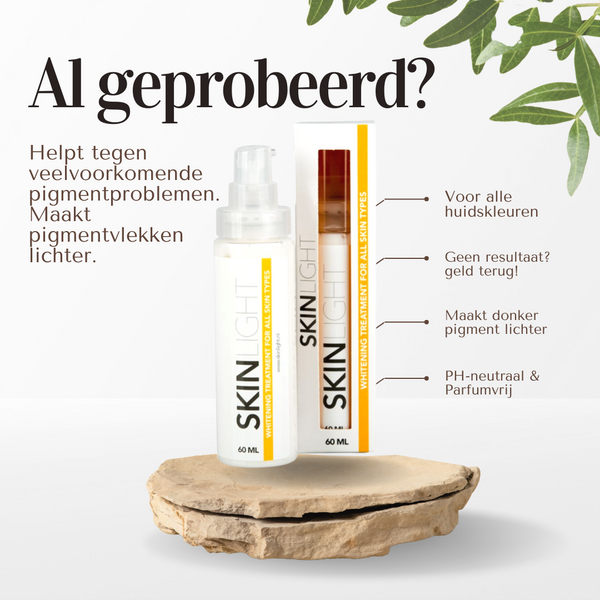Pigment spots on the face can cause discomfort and uncertainty for many people. The spots can be caused by an excessive production of melanin in the skin, also known as hyperpigmentation. Fortunately, there are ways to prevent and treat these stains. In this article we give you an overview of the causes, preventive measures and treatments for pigment spots on the face.
What are pigment spots?
Pigment spots are dark spots on the skin, which are caused by an excess of pigment in the skin. This can be due to various causes, such as hormonal changes, sun exposure or an excessive production of melanin. Pigment spots are also called age spots, because they often arise with age. Pigment spots can also be caused by post-inflammatory hyperpigmentation, which are spots on the skin that arise after inflammation or damage to the skin.
Causes of pigment spots on the face
There are several causes of pigment spots on the face. The main causes are:
- Sun exposure
The sun is one of the biggest culprits when it comes to pigment spots. When the skin is exposed to UV radiation, more melanin is produced to protect the skin against the harmful rays. This can lead to overproduction of melanin, resulting in pigment spots.
- Hormonal changes
Hormonal changes can also lead to pigmentation on the face. This can occur, for example, during pregnancy, when using contraceptive pills or during menopause.
- Excessive production of melanin
An excessive production of melanin can also cause pigmentation on the face. This can occur, for example, in people with a dark skin color.
- Skin damage
Damage to the skin can lead to post-inflammatory hyperpigmentation, where spots appear on the skin after inflammation or damage to the skin.
Prevent pigment spots
Pigment spots can be prevented by properly protecting the skin from the sun and by avoiding other factors that can cause hyperpigmentation. Here are some tips to prevent pigment spots:
- Protect your skin from the sun
Protect your skin from the sun by wearing a hat or cap, sunglasses and using sunscreen with a minimum SPF30. Reapply sunscreen every two hours, especially if you spend a lot of time outdoors.
- Avoid excessive sun exposure
Avoid excessive sun exposure, especially between noon and 3 p.m., when the sun is strongest. Seek shade or stay indoors during the hottest hours of the day.
- Wear protective clothing
Wear protective clothing, such as a long-sleeved shirt or pants, to protect your skin from the sun.
- Use an umbrella
Use an umbrella to protect yourself from the sun when you are outside.
- Avoid hot showers and baths
Avoid hot showers and baths as this can dry out the skin and make it more prone to hyperpigmentation.
- Avoid smoking and alcohol
Smoking and alcohol can damage the skin and cause hyperpigmentation. Avoid these habits to keep your skin healthy.
Treatments for pigment spots on the face
If you already have pigment spots on your face, there are several treatments you can consider to make them less visible. Below we discuss a number of effective treatments for pigment spots.
- Chemical peels
Chemical peels can help reduce pigmentation by removing the top layer of skin. This stimulates the growth of new, healthy skin cells and can help reduce pigmentation. There are several types of chemical peels available, including glycolic acid and salicylic acid peels.
- Laser treatments
Laser treatments can help to reduce pigment spots by breaking down the pigment in the skin. This can help to make the spots less visible and even out the skin. There are different types of lasers available, including the Fractional CO2 laser and the Alexandrite laser.
- Microdermabrasion
Microdermabrasion is a treatment in which the top layer of the skin is removed by means of small crystals. This can help to reduce the pigment spots and even out the skin.
- Serum creams
There are several creams and serums available that can help reduce pigment spots. These products often contain ingredients such as vitamin C, which is known for its properties to brighten the skin and reduce pigmentation. Other ingredients that may help include niacinamide, retinol, and arbutin.
- Camouflage make-up
Camouflage make-up can help to make the pigment spots less visible. This make-up contains pigments that adhere to the skin and neutralize the color of the spots. This makes the spots appear less noticeable and you can show your skin more confidently.
Additional tips in addition
In addition to the aforementioned treatments, I would like to give you some extra tips to prevent pigmentation spots on the face. An important tip is to reduce stress. Stress can lead to hormonal changes, which can be one of the causes of pigment spots. So make sure you relax enough and try to avoid stressful situations.
Another way to prevent pigment spots is to adopt a healthy lifestyle. This means that you eat healthy, exercise enough and get enough sleep. A healthy lifestyle can keep your skin healthy and less prone to pigment spots.
In addition, it is important to take good care of your skin. Use mild products specially formulated for sensitive skin, and avoid harsh products that can damage the skin and cause pigmentation. Cleanse your skin daily and use a good moisturizer to keep your skin hydrated.
Completion
Pigment spots on the face can be very annoying, but luckily there are ways to prevent and treat them. Protecting the skin from the sun and avoiding other factors that can cause hyperpigmentation is essential to prevent pigmentation. If you do have pigmentation spots on your face, there are various treatments available, such as chemical peels, laser treatments, microdermabrasion, creams and serums and camouflage makeup. It is important to remember that treating pigment spots can take time and patience. It is also important to know that some treatments are not suitable for all skin types. Therefore, always talk to a dermatologist before starting a treatment.
Answers to frequently asked questions
- What is the cause of pigment spots on the face?
Pigment spots can have a variety of causes, including sun exposure, hormonal changes, excessive melanin production, and skin damage.
- How can I prevent pigment spots on the face?
You can prevent pigment spots on the face by protecting your skin from the sun, avoiding excessive sun exposure, wearing protective clothing, avoiding hot showers and baths, and avoiding smoking and alcohol.
- What treatments are available for pigment spots on the face?
There are several treatments available for pigmentation spots on the face, such as chemical peels, laser treatments, microdermabrasion, creams and serums and camouflage makeup.
- How long does it take for pigment spots to diminish after treatment?
Reducing pigment spots after treatment can take time and patience. It can take several weeks to months before you see results.
- Are there any risks associated with facial pigmentation treatments?
Some treatments for facial pigmentation can carry risks, such as irritation, redness, and swelling. It is therefore important to always talk to a dermatologist before starting any treatment.
6. How can nutrition contribute to the prevention of pigment spots on the face?
A healthy diet with sufficient vitamins and antioxidants can help prevent pigment spots on the face. For example, vitamin C is important for the production of collagen, which keeps the skin firm and can prevent pigment spots.
7. Can taking certain medications cause pigmentation on the face?
Yes, some medications can lead to hyperpigmentation, including some antibiotics, hormone preparations, and chemotherapy. Discuss any pigmentation spots with your doctor if you are taking medication.
8. Are there any natural remedies that can help reduce pigmentation on the face?
Some natural remedies can help reduce pigmentation on the face, such as using lemon juice, aloe vera, turmeric, and vitamin E oil. However, it is important to remember that not all remedies are equally effective and some may even cause irritation. Therefore, always consult a dermatologist before using natural remedies.




















